
Quilt created by "Bag Ladies" of Lusk,
illustrating historic structures of Lusk. Photo used with permission of
the Bag Ladies and
Niobrara County Public Library.
L to R, First row: Deadwood Stage, formerly owned by Russell Thorp; Northwestern Hotel, see photo below; Lusk Depot;
Northwestern train and water tower; Ranger Hotel, see next page.
Second Row: National Guard Armory, now museum; Dell Burke's Yellow Hotel, see
text below; Niobrara County Carnegie Library; Congregational Church, now
First Baptist Church; Saloon.
Third Row: Silver Cliff Hotel; Outhouse; 1910 High School, now Elks Lodge, see
photo on subsequent page; Tri-State Milling Company; St. George Episcopal Church, see photo on
subsequent page.
Fourth Row: Fraternal Hall, see photo lower on page; Lusk High School; Gerald Bardo House;
Henry Hotel, now Hospitality House; Great Western Milling & Mining.
Fifth Row: Salverson Blacksmith; C & H Refinery; Frank Lusk House, now
funeral home; Royal Apartments; J. H. Hall Lumber Company.
Sixth Row: The Big Ironclad at Silver Cliff; Lusk Free Lance Newspaper;
Niobrara County Courthouse and Jail; H. C. Snyder Mercantile, see photo below;
Catholic Church, now Niobrara Southern Baptist.
The quilt depicted above was made in 2001 by the Bag Ladies as a fund raiser in
support of the Library. The individual Bag Ladies contributing
blocks to this historic appliquéd quilt include:
Wanda Lorenzen,
Dorthy Lohr,
Edith Culver,
Wyoma Hales,
Nadine Johnson,
Evelyn Perry,
Marilyn Cockreham,
Zola Bolin, with
Quilting by Dorothy Shimp of
Torrington, Wyoming. The library remains housed in the historic Carnegie Library.
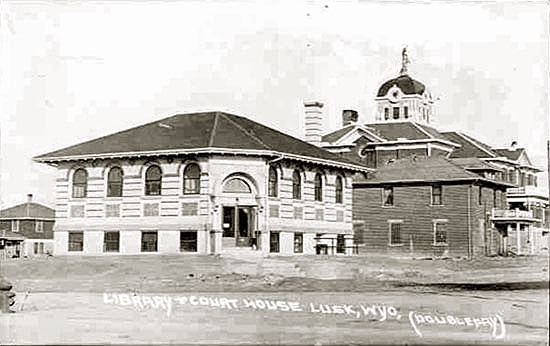
Niobrara County Public Library and Courthouse, approx. 1920. Photo by Ralph Doubleday.
The contract for the courthouse was $57,602.50 including $2,000 for the gold statue of Justice on the
cupola, but exclusive of plumbing, heating and wiring or luxuries such as the
judge's bench. As will be observed in the next photo, Justice was removed from the Courthouse. She
had a tendency to vibrate in the wind causing damage to the roof.
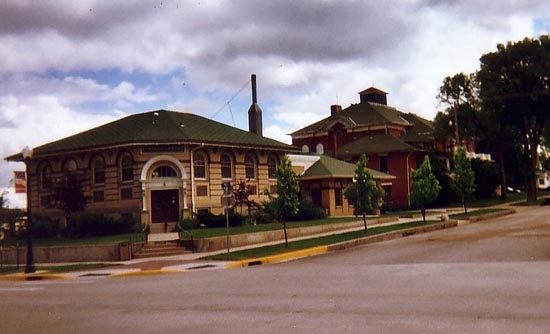
Niobrara County Public Library and Courthouse, 2005. Photo by Geoff Dobson
After the removal of Justice from the Courthouse, she sat in
ignominy behind the building. There, someone had turned her into a painted woman by decorated her cheeks with red paint.
Ultimately, Justice was driven away from the Courthouse grounds in a wagon.
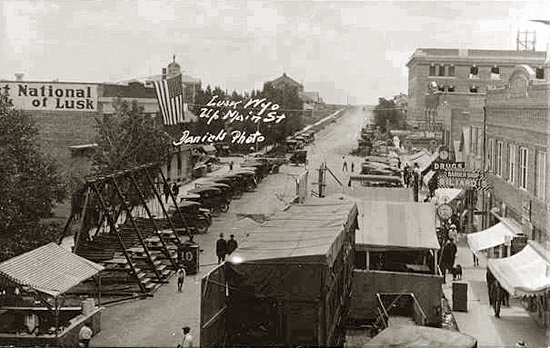
Ranger Hotel under construction, 1920. Photo by H. R. Daniels. The Statue of Justice may be seen above the American
Flag on the bank.
Niobrara County, of which Lusk is the county
seat, was formed in 1911 out of the eastern portion of Converse County, which, in turn,
had been formed out of portions of Albany and Laramie Counties in 1888. Upon the formation of
Converse County. Lusk and Manville both vied with Douglas to be the
County seat of Converse County. Although Douglas won, the editor of the Budget in Douglas complained,
after the election, of Lusk's and Manville's zeal to become county seat, contending that
Lusk had permitted children, canary birds and poodle dogs to vote, and that
of the 226 votes for Manville, 200 were fraudulent.
In 1911, there was equal bitterness over whether Niobrara County should be split off from Converse County.
Those around Manville and Keeline were generally against formation, although, in Manville,
Addison Spaugh supported the new county. The prime movers behind the
formation of the new county were H. C. Snyder, Thomas Bell, Russell Thorpe, and
George Voorhees. Adamantly opposed were the editor of the Manville Register and former legislator Nat Baker,
indeed, to such an extent that Baker threatened Snyder with a shootout.
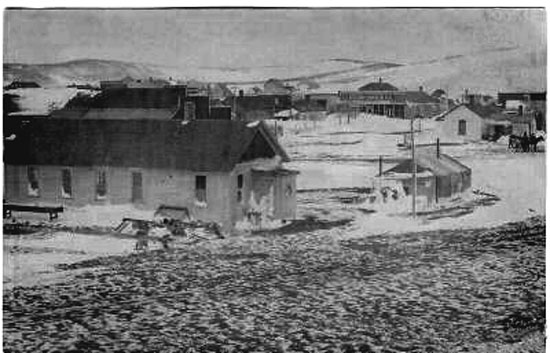
Lusk, April 13, 1912. In distance is H. C. Syner's store.
Harry Snyder (1861-1916) came up the Texas Trail with John B. Kendrick in 1879. As discussed elsewhere, Kendrick
became foreman for the WO and ultimately in Sheridan became a cattle baron, real estate entrepreneur, and
United States senator. Snyder was employed by at George Keeline's 4J ranch and also on the JM before being employed by
Luke Voorhees at foreman of voorhees' L Z Ranch at Rawhite Buttes. Vorhees was the proprietor of the
Deadwood stage line. About 1895, Snyder bought out
Baker Brothers Groceries. At the time of his death, he was a past master of Harmony Lodge of the Masons and was
Grand Junior Warden of the Wyoming Masonic Grand Lodge. The store was liquidated in 1932. Its site was later occupied by a service station.

H. C. Snyder's Store, west side of Main Street, looking south, 1920.
In the distance is the imcomplete Ranger Hotel.
Although construction of the Ranger commenced in 1919, it was not completed until 1928.

Northwest corner of Main andSecond Streets, 1920.
As will be observed, during a spring thaw, the streets turn to mud, a sticky, gunky partially clay mud, referred to as gumbo.
The 19th Century artist Thomas Moran wrote of gumbo:
When wet it is the blackest, stickiest, most India-rubber-like mud that extists on earth. Like the
gathering snowball, it accumulates on whatever comes in contact with it, and is so adhesive that
it never falls away of its own weight, as any well regulated mud will do, but must be
laboriously removed when you or your wagon-wheels become clogged with it. * * * * The horses * * *
started off cheerfully; but the terrible gumbo soon began to discourage them. We tried walking to
relieve them of our weight, but soon found that the friendly gumbo had us in its embrace, making our
feet like lead."Century Magazine, "Artists' Adventures," 1893.
Compared to
gumbo, Georgia clay in its wimpiness turns red with embarassment. Walking across
a corral in the gumbo is an adventure. One's boots sink into the mire. A vacuum formed with the
clay threatens to suck the boots completely off. If one reaches down to grab the tops of the boots to lift one's feet
out of the gumbo, one may very well take a tumble into the gunk.

West side of Main street looking north, 1920.
As can be seen from the sign, past Barnes' Hardware is a combination furniture store and undertaking parlor. Such combinations
were common in the late 19th and early 20th Centuries. In the late 1800's it was common for the dead
to be laid out at home. Caskets were sold in furniture stores. Often, however, when the home was not
suitable for laying out of the deceased, the owner of the furniture store might be asked to
undertake the arrangements. Thus, the practice of having combination businesses became common. Combination
furniture stores and funeral parlors were found in Cheyenne, Rawlins, Riverton, as well as Lusk. Nor was
the combination business limited to Wyoming. Bonnie and Clyde after they were killed were laid out in a
furniture store. Because of the fame of the deceased, the poor undertaker found himself
beseiged in his furniture store, keeping back the crowds by squirting them with embalming fluid.
In Orlando, Florida, one early undertaker combined his furniture-undertaking business with a livery stable. He already
had the horses for the hearse and the furniture delivery wagon. In one town, the undertaker used
the same vehicle as a hearse and furniture delivery wagon. It was customary when a hearse passed, for men to
take off their hats and place them over their hearts as a token of respect. To solve the problem of
men standing in respect for a load of furniture, white horses were used for the furniture and black horses for
the deceased. Hearses were affixed with ostrich plumes, white for children and
unmarried women and black for others. One's social standing was sometimes marked by the number of plumes. Today, it is marked by
the number of traffic cones placed in front of the church.
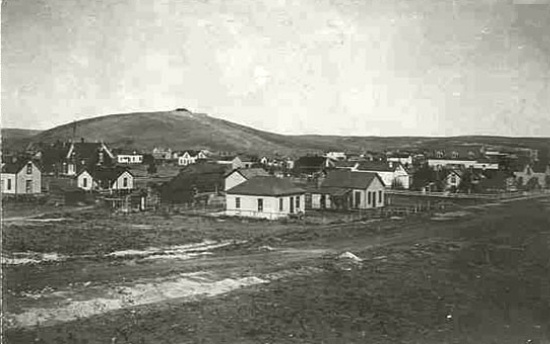
Lusk, approx. 1910.
Next page: Lusk Continued.
|